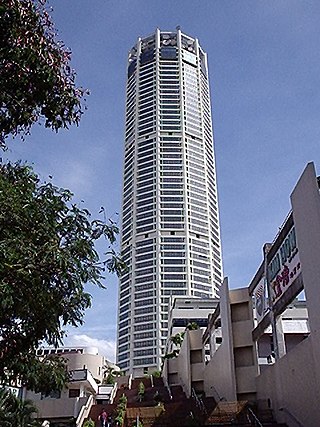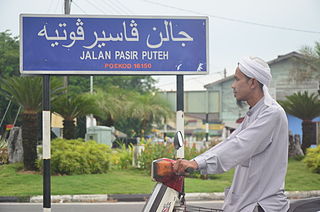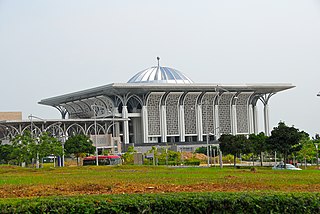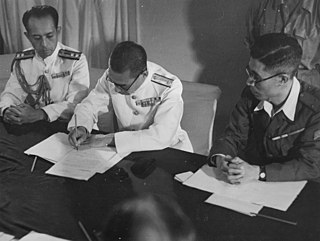Related Research Articles

The South-East Asian Theatre of World War II consisted of the campaigns of the Pacific War in the Philippines, Thailand, Indonesia, Indochina, Burma, India, Malaya and Singapore between 1941 to 1945.

The term "British Malaya" loosely describes a set of states on the Malay Peninsula and the island of Singapore that were brought under British hegemony or control between the late 18th and the mid-20th century. Unlike the term "British India", which excludes the Indian princely states, British Malaya is often used to refer to the Federated and Unfederated Malay States, which were British protectorates with their own local rulers, as well as the Straits Settlements, which were under the sovereignty and direct rule of the British Crown, after a period of control by the East India Company.

The then British colony of Malaya was gradually occupied by the Japanese between 8 December 1941 and the Allied surrender at Singapore on 16 February 1942. The Japanese remained in occupation until their surrender to the Allies in 1945. The first Japanese garrison in Malaya to lay down their arms was in Penang on 2 September 1945 aboard HMS Nelson.
This article lists important figures and events in Malayan public affairs during the year 1960, together with births and deaths of significant Malayans.

This article lists important figures and events in Malayan and Malaysian public affairs during the year 1963, together with births and deaths of significant Malaysians. The Federation of Malaya merged with Singapore, North Borneo, and Sarawak to form the Federation of Malaysia on 16 September.

This article lists important figures and events in Malaysian public affairs during the year 1965, together with births and deaths of significant Malaysians. Singapore left the Federation of Malaysia on 9 August.

This article lists important figures and events in Malaysian public affairs during the year 1985, together with births and deaths of notable Malaysians.
This article lists important figures and events in Malayan public affairs during the year 1961, together with births and deaths of significant Malayans.

This article lists important figures and events in Malaysian public affairs during the year 1977, together with births and deaths of notable Malaysians. MAS Flight 653 was hijacked and crashed in Johor on 16 December, killing 100 people.

This article lists important figures and events in Malaysian public affairs during the year 1967, together with births and deaths of notable Malaysians.

The British Military Administration (BMA) was the interim administrator of British Malaya from August 1945, the end of World War II, to the establishment of the Malayan Union in April 1946. The BMA was under the direct command of the Supreme Allied Commander South East Asia, Lord Louis Mountbatten. The administration had the dual function of maintaining basic subsistence during the period of reoccupation, and also of imposing the state structure upon which post-war imperial power would rest.

Operation Tiderace was the codename of the British plan to retake Singapore following the Japanese surrender in 1945. The liberation force was led by Lord Louis Mountbatten, Supreme Allied Commander of South East Asia Command. Tiderace was initiated in coordination with Operation Zipper, which involved the liberation of Malaya.

This article lists important figures and events in Malaysian public affairs during the year 2010, together with the deaths of notable Malaysians. Malaysia Day, 16 September was celebrated as a national holiday for the first time.
Malaysian Sikh community is known to be the fourth largest Malaysian Indian ethnic group. It is estimated that there are around 100,000 Sikhs in Malaysia.
The history of Japanese migration in Malaysia goes back to the late 19th century, when the country was part of the British Empire as British Malaya.

The Battle of Kuala Lumpur was a battle between Japanese invasion forces and the British forces in Kuala Lumpur, in the then capital of the Federated Malay States, a British protectorate.
Malaya Cup was an association football tournament held by a Malaya Cup committee. The inaugural tournament was run by the Selangor Club.
Operation Mailfist was a planned Allied offensive to liberate Singapore from Japanese occupation during World War II. It was intended to follow on from the landing in Malaya, Operation Zipper, and take place between December 1945 and March 1946. However, it was not conducted as Japan surrendered shortly before Operation Zipper was to have been launched. Instead, Singapore was re-occupied in the unopposed Operation Tiderace.
This article lists important figures and events in the public affairs of British Malaya during the year 1941, together with births and deaths of prominent Malayans. The Japanese occupation of Malaya started in December 1941.

Operation Jurist referred to the British recapture of Penang following Japan's surrender in 1945. Jurist was launched as part of Operation Zipper, the overall British plan to liberate Malaya, including Singapore.
References
- ↑ Bayly, Christopher Alan; Harper, Timothy Norman (2007), Forgotten wars: Freedom and Revolution in Southeast Asia, ISBN 9780674021532
- ↑ "Obituary:Tun Ibrahim Ismail". The Daily Telegraph. 26 January 2011. Retrieved 30 January 2011.
- 1 2 Bayly; Christopher Alan, Harper, Timothy Norman (2007). Forgotten Wars: Freedom and Revolution in Southeast Asia . United States: Harvard University. ISBN 9780674021532.
{{cite book}}: CS1 maint: multiple names: authors list (link) - ↑ JAPANESE SIGN THE SURRENDER OF PENANG ABOARD HMS NELSON (3/9/1945), Colonial Film, 3 September 1945, retrieved 12 June 2011
- ↑ H.M.S. Attacker
- ↑ H.M.S. Hunter